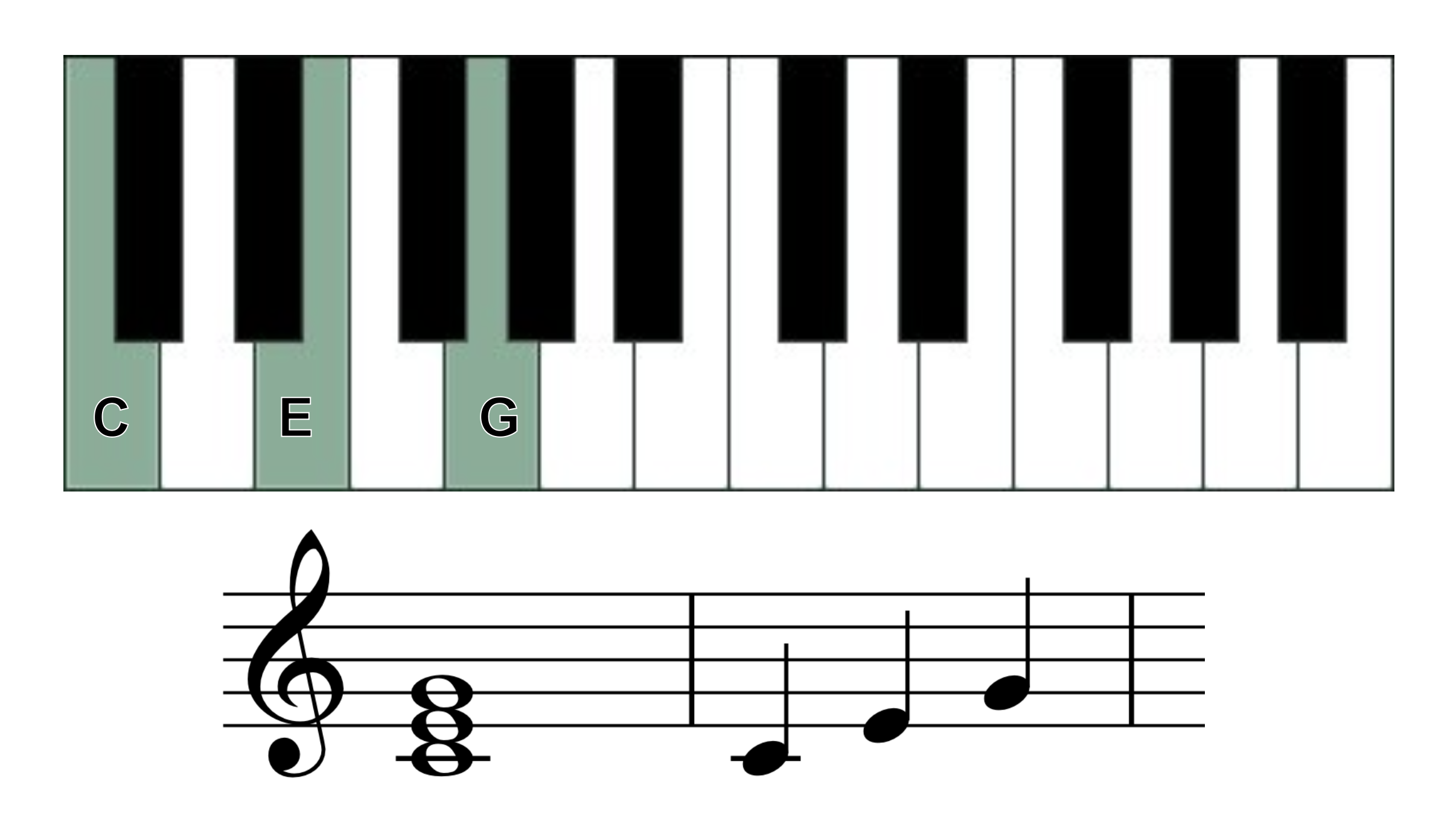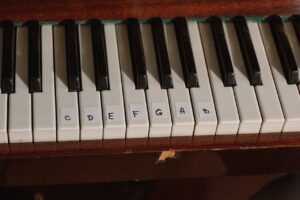The C major chord is often where a piano chord journey begins. It sounds clear, bright, and just plain great, even if it’s the very first chord you ever play. In this article we will look at how to play the C major chord, all of its inversions and what fingerings to use. We will also look at common chord progression in C and some great songs that use this chord so you can master it in no time with a little help from Skoove. Let’s get started!
How to play the C major chord in root position?
To play the C major triad, all you need are three white keys: C, E and G. Start by finding C, it’s the white key right before the two black keys. Then add E and G on top.

The C major chord is made of three notes: C, E and G.
These notes are called the root (C), third (E) and fifth (G). Together, they create a bright and happy sound.
To play this chord in its root position (basic form) with your right hand, use these fingers:
- G – Fifth finger (5)
- E – Third finger (3)
- C – Thumb (1)
For the left hand, use the following fingers:
- G – Thumb (1)
- E – Third finger (3)
- C – Fifth finger (5)
What are the inversions of C major chord?
The inversions of the C major piano chord are formed by rearranging the order in which the notes are stacked. Chord inversions allow you to play the same chord with a slightly different feeling and control how you hear each note of the chord. Let’s break down inversions and discover how to play them on the piano.
Let’s break down these inversions further and discover how to play them on the piano.
How to play C major the 1st inversion?
To play the first inversion of the C major piano chord, start with E as the lowest note. Next, play G above it and finally, add C as the top note. This gives the chord a fresh sound, great for smooth transitions between chords.

For the right hand, use these fingers:
- E – Thumb (1)
- G – Middle finger (3)
- C – Fifth finger (5)
For the left hand, use these fingers:
- E – Fifth finger (5)
- G – Third finger (3)
- C – Thumb (1)
How to play C major 2nd inversion?
To play the second inversion of the C major piano chord, start with G as the lowest note. Then, play C above it and finally add E as the highest note. This inversion gives the chord a new texture and is perfect for smooth chord transitions.

For the right hand, use these fingers:
- G – Thumb (1)
- C – Middle finger (3)
- E – Fifth finger (5)
For the left hand, use these fingers:
- G – Fifth finger (5)
- C – Third finger (3)
- E – Thumb (1)
Common chords progressions in the key of C major
The C major chord progression is widely used in lots of genres, from rock and pop to jazz and classical music. A C major chord progression often includes chords like C, F, G and Am. Here are some popular C major chord progressions:
- C – Am – F – G
- C – G – Am – F
- C – G – F – Dm
- C – Am – G – B
These progressions are great for beginners just getting into chords, offering a range of moods from somber to uplifting. They are a great way to put your knowledge of piano chords to the test. To get to grips with some basic chord symbols and how to play them, take a look at Skoove’s tailor-made beginner chord progression courses.
Popular songs to play with the C major chord
Post Malone – Better Now
Carl Cerny – Cerny op. 599 No.1
Piano chords generator
💡 If you are reading this from a mobile device, rotate it to display the tool in full width.
1. Click on “Chords”
2. Choose the “Root” of the chord
3. Choose the “Chord qualities” (major, minor, etc.)
4. Click “Display”
Author of this blog post:
Matthew Dickman

With over a decade of experience in music education Matthew holds a BA in Music from Paul McCartney’s LIPA and an MA in Composition from the University of Salford. Mathew has developed a distinctive compositional voice and approach to music theory education through his research and work in the music industry. Matthew’s writing for Skoove combines experience from orchestral and media composition, and as a gigging jazz musician, to create a wholistic and accessible pedagogy for musicians of any level. Away from music, he enjoys reading and exploring nature to expand his horizons and knowledge contributing to his holistic teaching style.













